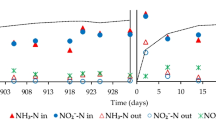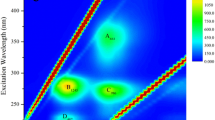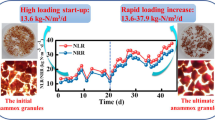Abstract
Preserving active anaerobic ammonium oxidation (anammox) biomass is a potential method for securing sufficient seeding biomass for the rapid start-up of full-scale anammox processes. In this study, anammox granules were cultured in an upflow anaerobic sludge blanket (UASB) reactor (R0), and then the enriched anammox granules were preserved at 35, 20, 4, and −30 °C. The subsequent reactivation characteristics of the granules were evaluated in four UASB reactors (denoted R1, R2, R3, and R4, respectively) to investigate the effect of preservation temperature on the characteristics of anammox granules and their reactivation performance. The results demonstrated that 4 °C was the optimal preservation temperature for maintaining the biomass, activity, settleability, and integrity of the anammox granules and their cellular structures. During the preservation period, a first-order exponential decay model may be used to simulate the decay of anammox biomass and activity. The protein-to-polysaccharide ratio in the extracellular polymeric substances and the heme c content could not effectively indicate the changes in settleability and activity of the anammox granules, respectively, and a loss of bioactivity was positively associated with the degree of anaerobic ammonium-oxidizing bacteria cell lysis. After 42 days of storage, the anammox granules preserved at 4 °C (R3) exhibited a better recovery performance than those preserved at 20 °C (R2), −30 °C (R4), and 35 °C (R1). The comprehensive comparison indicated that 4 °C is the optimal storage temperature for anammox granular sludge because it promotes improved maintenance and recovery performance properties.







Similar content being viewed by others
References
Ali M, Okabe S (2015) Anammox-based technologies for nitrogen removal: advances in process start-up and remaining issues. Chemosphere 141:144–153
Ali M, Oshiki M, Okabe S (2014) Simple, rapid and effective preservation and reactivation of an anaerobic ammonium oxidizing bacterium “Candidatus Brocadia sinica”. Water Res 57:215–222
APHA (2005) Standard methods for the examination of water and wastewater, 21st edn. American Public Health Association, Washington, DC
Berry EA, Trumpower BL (1987) Simultaneous determination of hemes a, b, and c from pyridine hemochrome spectra. Anal Biochem 161:1–15
Ding S, Zheng P, Lu H, Chen J, Mahmood Q, Abbas G (2013) Ecological characteristics of anaerobic ammonia oxidizing bacteria. Appl Microbiol Biotechnol 97:1841–1849
Heylen K, Ettwig K, Hu ZY, Jetten M, Kartal B (2012) Rapid and simple cryopreservation of anaerobic ammonium-oxidizing bacteria. Appl Environ Microbiol 78:3010–3013
Ji YX, Jin RC (2014) Effect of different preservation conditions on the reactivation performance of anammox sludge. Sep Purif Technol 133:32–39
Jin RC, Yang GF, Yu JJ, Zheng P (2012) The inhibition of the Anammox process: a review. Chem Eng J 197:67–79
Jin RC, Ma C, Yu JJ (2013a) Performance of an Anammox UASB reactor at high load and low ambient temperature. Chem Eng J 232:17–25
Jin RC, Xing BS, Yu JJ, Qin TY, Chen SX (2013b) The importance of the substrate ratio in the operation of the Anammox process in upflow biofilter. Ecol Eng 53:130–137
Jin RC, Yang GF, Zhang QQ, Ma C, Yu JJ, Xing BS (2013c) The effect of sulfide inhibition on the ANAMMOX process. Water Res 47:1459–1469
Kartal B, Kuenen JG, van Loosdrecht MCM (2010) Sewage Treatment with Anammox. Science 328:702–703
Lackner S, Gilbert EM, Vlaeminck SE, Joss A, Horn H, van Loosdrecht MCM (2014) Full-scale partial nitritation/anammox experiences—an application survey. Water Res 55:292–303
Leitão RC, van Haandel AC, Zeeman G, Lettinga G (2006) The effects of operational and environmental variations on anaerobic wastewater treatment systems: a review. Bioresour Technol 97:1105–1118
Lotti T, Kleerebezem R, Abelleira J, Abbas B, van Loosdrecht MCM (2015) Faster through training: the anammox case. Water Res 81:261–268
Ma C, Jin RC, Yang GF, Yu JJ, Xing BS, Zhang QQ (2012) Impacts of transient salinity shock loads on Anammox process performance. Bioresour Technol 112:124–130
Rothrock MJ, Vanotti MB, Szögi AA, Gonzalez MCG, Fujii T (2011) Long-term preservation of anammox bacteria. Appl Microbiol Biotechnol 92:147–157
Scaglione D, Caffaz S, Bettazzi E, Lubello C (2009) Experimental determination of Anammox decay coefficient. J Chem Technol Biotechnol 84:1250–1254
Strous M, Heijnen JJ, Kuenen JG, Jetten MSM (1998) The sequencing batch reactor as a powerful tool for the study of slowly growing anaerobic ammonium-oxidizing microorganisms. Appl Microbiol Biotechnol 50:589–596
van der Star WRL, Abma WR, Blommers D, Mulder J, Tokutomi T, Strous M, Picioreanu C, van Loosdrecht MCM (2007) Startup of reactors for anoxic ammonium oxidation: experiences from the first full-scale anammox reactor in Rotterdam. Water Res 41:4149–4163
Vlaeminck SE, Geets J, Vervaeren H, Boon N, Verstraete W (2007) Reactivation of aerobic and anaerobic ammonium oxidizers in OLAND biomass after long-term storage. Appl Microbiol Biotechnol 74:1376–1384
Wett B (2006) Solved upscaling problems for implementing deammonification of rejection water. Water Sci Technol 53:121–128
Wu X, Liu S, Dong G, Hou X (2015) The starvation tolerance of anammox bacteria culture at 35°C. J Biosci Bioeng 120:450–455
Xing BS, Guo Q, Zhang ZZ, Zhang J, Wang HZ, Jin RC (2014) Optimization of process performance in a granule-based anaerobic ammonium oxidation (anammox) upflow anaerobic sludge blanket (UASB) reactor. Bioresour Technol 170:404–412
Xing BS, Guo Q, Yang GF, Zhang ZZ, Li P, Guo LX, Jin RC (2015) The properties of anaerobic ammonium oxidation (anammox) granules: Roles of ambient temperature, salinity and calcium concentration. Sep Purif Technol 147:311–318
Xu G, Zhou Y, Yang Q, Lee ZM, Gu J, Lay W, Cao Y, Liu Y (2015) The challenges of mainstream deammonification process for municipal used water treatment. Appl Microbiol Biotechnol 99:2485–2490
Zhang ZZ, Buayi X, Cheng YF, Zhou YH, Wang HZ, Jin RC (2015) Anammox endogenous metabolism during long-term starvation: Impacts of intermittent and persistent modes and phosphates. Sep Purif Technol 151:309–317
Acknowledgments
The authors wish to thank the Natural Science Foundation of China (Nos. 51278162 and 51578204) for the support of this study.
Author information
Authors and Affiliations
Corresponding author
Ethics declarations
Funding
This study was funded by the Natural Science Foundation of China (Nos. 51278162 and 51578204).
Conflict of interest
The corresponding author on behalf of all authors of the paper declares no conflict of interest.
Ethical approval
This article does not contain any studies with human participants or animals performed by any of the authors.
Electronic supplementary material
Below is the link to the electronic supplementary material.
ESM 1
(PDF 629 kb)
Rights and permissions
About this article
Cite this article
Xing, BS., Guo, Q., Jiang, XY. et al. Influence of preservation temperature on the characteristics of anaerobic ammonium oxidation (anammox) granular sludge. Appl Microbiol Biotechnol 100, 4637–4649 (2016). https://doi.org/10.1007/s00253-016-7292-3
Received:
Revised:
Accepted:
Published:
Issue Date:
DOI: https://doi.org/10.1007/s00253-016-7292-3




